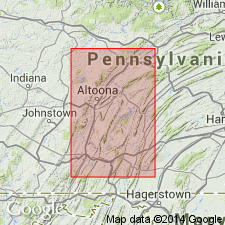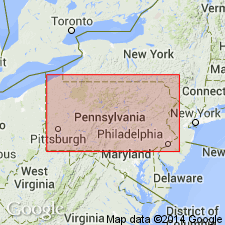
- Usage in publication:
-
- Run Gap red sandstone member
- Modifications:
-
- Named
- Dominant lithology:
-
- Sandstone
- AAPG geologic province:
-
- Appalachian basin
Summary:
Run Gap red sandstone member at top of Juniata formation is 250 ft thick at Run Gap. In Tyrone Gap area is represented by thin red sandstones. At Run Gap, unit is finely and sparingly conglomeratic. Overlies Plummer Hollow mudstone member (new); eastward from vicinity of Lost Creek Gap, overlies East Waterford red sandstone member (new). Age is Ordovician (Cincinnatian).
Source: GNU records (USGS DDS-6; Reston GNULEX).

- Usage in publication:
-
- Run Gap Member
- Modifications:
-
- Revised
- AAPG geologic province:
-
- Appalachian basin
Summary:
Revised the Run Gap to the Run Gap Member of the Juniata Formation. Unit is uppermost member of formation. Consists of thin-bedded sandstone with minor interbedded shale. Overlies the Plummer Hollow Member of the Juniata and underlies the Tuscarora Formation.
Source: GNU records (USGS DDS-6; Reston GNULEX).

- Usage in publication:
-
- Run Gap Member
- Modifications:
-
- Overview
- AAPG geologic province:
-
- Appalachian basin
Summary:
Subdivision of the Juniata Formation into three members in central PA is based largely on differences in the relative proportion of sandstone and mudrock. In the lowest East Waterford Member (lithofacies D of this report) red sandstones dominate over dark red mudrocks, and the sandstones are organized into beds that are medium to thick, cross-laminated, and laterally extensive and sheet-like. The middle Plummer Hollow Member (lithofacies E) contains more mudrock than sandstone, and the sandstone and mudrock are more or less regularly interbedded, in some places as fining-upward sequences. Abundant SKOLITHOS-like burrows filled with red mudstone occur in the sandstone. The upper Run Gap Member (lithofacies F) is largely red lithic wacke and underlies quartz arenite at the base of the Tuscarora Formation. Age is Ashgillian.
Source: GNU records (USGS DDS-6; Reston GNULEX).
For more information, please contact Nancy Stamm, Geologic Names Committee Secretary.
Asterisk (*) indicates published by U.S. Geological Survey authors.
"No current usage" (†) implies that a name has been abandoned or has fallen into disuse. Former usage and, if known, replacement name given in parentheses ( ).
Slash (/) indicates name conflicts with nomenclatural guidelines (CSN, 1933; ACSN, 1961, 1970; NACSN, 1983, 2005, 2021). May be explained within brackets ([ ]).

